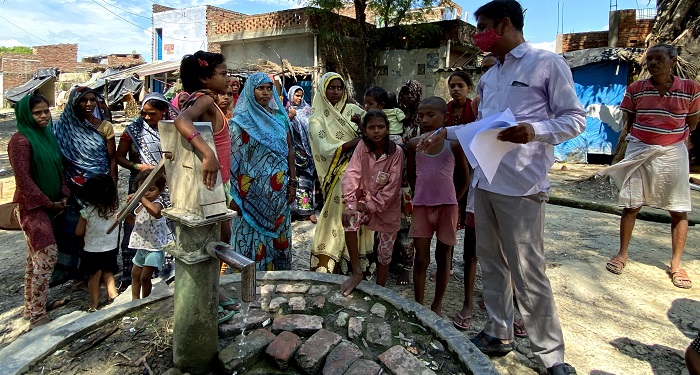Around 25 km from Lucknow in Akbarpur village of Bakshi ka Talab tehsil (administrative block) in Uttar Pradesh, women are leading their community to adopt safe drinking water and sanitation practices as they migrate to using tap water in their homes. Most people in the village are still dependent on shared water points and other unprotected water sources for their drinking and household needs.
Women and girls in India have been powerful drivers of change for climate adaptation and risk mitigation in their homes, communities and at the policy level. Their participation and leadership in sustainability initiatives have led to inclusive and effective climate action and their contribution is being celebrated on International Women’s Day on 8 March 2022, which calls for ‘Gender equality today for a sustainable tomorrow’.

Community-led Water Safety Planning committees have been set up in Akbarpur village to address issues of environmental contamination of earth and water sources. (©Aga Khan Foundation/WHO India)
In August 2019, Prime Minister Mr Narendra Modi announced the launch of the Jal Jeevan Mission with a budgetary outlay of approximately ₹3.5 trillion to provide Functional Household Tap Connection (FHTC) for safe drinking water to all rural households in India by 2024. Following the announcement, state governments began preparing detailed project plans to implement this programme and give wings to the dreams of millions of women who spend many hours walking in the scorching heat to fetch water for their families.
To sustain efforts to implement the Jal Jeevan Mission, the Aga Khan Foundation with the support of WHO India implemented a Water Safety Planning Framework in 10 villages in Uttar Pradesh, of which Akbarpur is one, in September 2021. These villagers are presently dependent on India Mark 2 Handpump for drinking water and will be connected FHTC under Jal Jeevan Mission.
Discussions led by the community identified water contamination linked to animals being tied near water sources which in turn led to wastewater and faecal sludge discharge into the village pond. This encouraged community members, particularly women, to take up the ownership of safeguarding hand pumps to protect the health of the community.

Water Safety Planning teams were trained on water quality testing using field testing kits and surveillance to assess water sources for safety and contamination. (©WHO India)
Five women and five men volunteered to form a Water Safety Planning (WSP) Team. The WSP team started a transect walk along with community members, village water and sanitation committee and Pradhan (elected head of the Panchayat or village committee) to build rapport with the community and introduce them to the Water Safety Plan.
Subsequently, a water supply system risk assessment was done using a semi-quantitative risk matrix approach recommended by the WHO water safety plan guidelines. The WSP team was trained on testing water quality and safety using field kits, H2S vials and surveillance to assess contamination. The results of the assessment were listed on an 8x8 feet printed matrix and the community then discussed their water safety plans based on evidence generated from the field tests.
Ms Indu Singh, Ms Shivani, Ms Anita and Ms Sunita emerged as the women leaders during the discussion and are now training others in the management of drinking water sources. These women change-makers have leadership roles in the village committees and have undertaken the responsibility for regular assessment and monitoring of all the drinking water from source to taps as the Jal Jeevan Mission gets implemented in their village.
